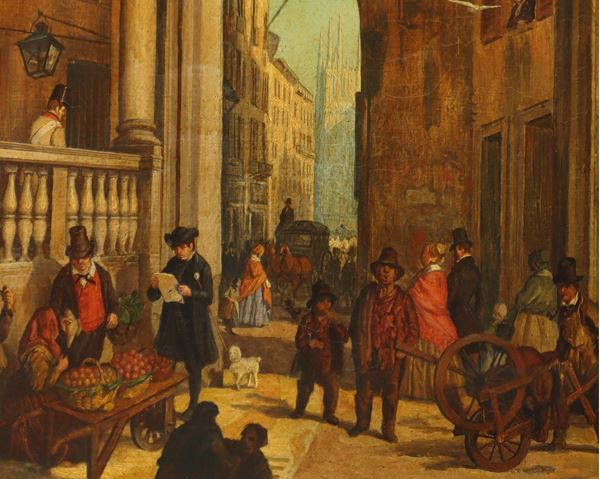Angelo Inganni (Brescia, 1807 - Gussago, 1880)
View of the Piazza dei Mercanti or the passage from the Piazza dei Mercanti to the Pescheria Vecchia
Signed and dated lower right.
Expertise by Professor Claudio Strinati:
"The very fine painting is signed by Angelo Inganni and is a typical work of his late period, that is, executed during the eighth decade of the nineteenth century, when the master, after various and interesting events that developed between Milan and Vienna, devoted himself with great commitment and fervor to the representation of daily life in the city, with a very happy sense of perspective and with a magnificent attitude towards narrative painting crowded with always strongly characterized figures, scattering his paintings with anecdotes and episodes of every kind that render as well as possible the tumult of a very lively and teeming life.
Since his early youth, to be fair, Inganni had followed this type of approach but over time his style had become more minute and delicate and our painting, here under examination, fully reflects this extreme stylistic change. In this work, then, one can still feel very vividly the influence, which had been decisive in his first phase, of the great "city painters" belonging to the generation that preceded him, such as the Piedmontese Giovanni Migliara or the Venetian Giuseppe Canella.
From these artists Inganni draws, in fact, that taste for urban storytelling that characterizes many memorable moments of European painting in the first half of the nineteenth century.
But compared to his predecessors, Inganni has more than ever the right to be considered (as our painting sufficiently demonstrates) the painter par excellence of the common people and the lower middle class.
In our painting, they stand next to each other with naturalness and simple spontaneity, but at the same time the artist's eye is lovingly involved with the joys and sufferings of everyday life. All this is set in a very precise perspective structure where the gaze ranges towards distant horizons that loom over the closed maze of alleys and small squares.
The area of Milan depicted in the painting under examination here is the one where the painter worked for decades, around the Church of San Marco, which still exists even if profoundly transformed by modern urban planning.
A beautiful testimony of a truly distinguished painter with a work, moreover, perfectly preserved."










